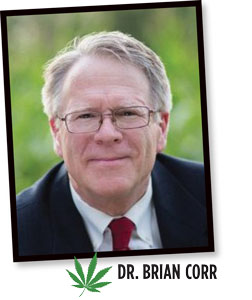1/1/2018
The Green Rush
Dr. Brian Corr

Editor’s note: We’re proud to introduce this brand-new column (which will be in the magazine every other month) by an esteemed industry notable that will focus on the cannabis market. Whether you’re interested, dabbling or already growing cannabis full steam ahead, our hope is that Dr. Corr keeps you up to date on news, research and trends for this new segment.—JZ
In every boom there are winners and losers, but in every boom one group does well. During the California gold rush of the mid-1800s some “49ers” (prospectors, not the football team) made fortunes, many lost everything and some lost their lives. However, the group that did just fine were the ones who opened hotels, ran saloons, sold picks and shovels, or otherwise supplied the miners with what they needed. A guy named Levi Strauss came along late in the game and did pretty well selling to miners who needed well-constructed trousers.
The cannabis world is in a boom; a “green rush.” Already there are people making vast sums of money, people who have lost vast sums of money, and some folks doing just fine selling equipment and supplies to the industry—the equivalent of picks and shovels. These columns will be about these people and the cannabis industry in general. As the author of this column and a sometimes consultant to the industry, I guess that makes me a sort-of Levi Strauss.
Depending on your perspective, I’m either a latecomer to the green rush or an old-timer. In comparison to those who have been growing illegally for decades, or growers in California (Prop 215 allowing for medical use of cannabis passed in 1996), I’m VERY new. I’ve been involved in the state-legal cannabis world for almost four years, but since cannabis years turn faster than calendar years—even faster than dog years—that seems like a long time. In that time, I’ve assisted in writing applications in four states and watched those four and eight others join a total of 29 states (and the District of Columbia) with some form of state-legal cannabis production and sale. I’ve continued to consult regarding cannabis production where it’s state-legal and outside the United States.
I’m one of the most unlikely people to have become involved writing cannabis applications. Like many people, I assumed “medical” cannabis was just an excuse for getting high. However, a recruiter approached me during a time in my career when I was looking for work and asked if I would consider an “interesting” project. Working with people in the cannabis industry has turned out to be some of the most interesting work I’ve done in over four decades of working in horticulture.
I’ve become convinced of medical benefits of cannabis by reading the scientific literature, but more so by speaking with people who have benefited from the medical use of cannabis. For example, I met a guy who had a spinal cord injury that left him largely paralyzed from the waist down. He was prescribed many drugs to minimize pain and spasms. These medications had significant side effects, not the least of which was making him nearly comatose when he took enough to relieve symptoms, to the point he could do almost nothing.
After trying medical cannabis, he was able to wean himself from many of the prescription drugs. He’s now a very active member of his community and able to use a hand-controlled pickup truck, even plowing driveways for neighbors. I’ve spoken with many others, with similar
stories, and will share some of those stories in future columns.
If patients benefit from medical cannabis, and if 29 states (and D.C.) allow production and sale of some form of cannabis, why is there any controversy? It cannot be clearer—the production, sale, possession and use of cannabis is prohibited under U.S. federal law. Although states have developed laws contrary to federal law, that doesn’t change federal law. In future columns, I’ll describe some of the problems this creates.
Despite the problems of U.S. federal prohibition, the cannabis industry is developing quickly in the United States and even more quickly worldwide. I’ll attempt to show parallels to, and demonstrate differences from, more conventional crops.
A few words about terminology—there may be more common names for Cannabis sativa than any other plant in cultivation: marijuana, marihuana (at least in Michigan), weed, grass, pot, ganja, etc. In these columns, I’ll generally be using “cannabis” to describe the plant with medical or psychotropic effects. Technically, “cannabis” includes non-psychotropic forms of the plant, typically called hemp. However, the lines are fuzzy. In Canada, and in some states, any cannabis containing less than 0.3% delta-9-tetrahydrocannabinol (THC, the stuff that gets people high) is hemp, not marijuana. However, the U.S. government considers any trace of THC sufficient to label cannabis as “marijuana,” not hemp, and therefore, federally illegal. When necessary, I’ll indicate if I’m talking about non-psychotropic cannabis.
Whether you’re in favor of or opposed to current regulations regarding cannabis, there can be no doubt the cannabis industry is having seismic effects on traditional horticulture. I look forward to sharing thoughts and observations with you in future columns. GT
Dr. Brian Corr is a consultant with more than four decades of experience in the greenhouse industry. He has advised legal cannabis producers for the last three years. You can reach him at
Brian.Corr@SycamoreHortConsulting.com.